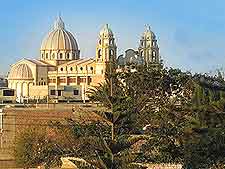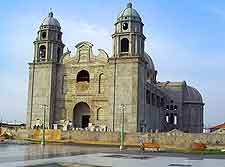Chimbote History Facts and Timeline
(Chimbote, Ancash, Peru)

Perched in the middle of Peru's Pacific Ocean coastline, Chimbote is the capital of both its namesake district and the Peruvian province of Santa.
With a 12-km / 7-mile long port and two stunning natural bays, the city comes with an interesting history and is now called home by in excess of 25 individual fish factories, encompassing some three-quarters of modern Peru's total fishing industry. Visitors can best see the beautiful Samanco and Chimbote bays from the top of the city's adjacent 'Mountain of Youth'.
Founding of the City
The city's original residents were the Recuay, the Inca, the Wari and the Moche peoples. Very little is known about local history prior to the mid-1770s, the year that the city's name was officially documented for the first time. Chimbote's name is a combination of two Greek words meaning 'boat' and 'cross to the opposite bank.' Chimbote history remembers that the first official acknowledgement of the community took place in 1835, when close to 1,000 people lived in this small fishing village.
Railroads and Highways
Even after Chimbote became the starting point of a railroad linking the community to the inland city of Huallanca in 1871, the community's population only increased by about 200 people. The 1930s opening of the Pan-American Highway made travel between Chimbote and
Lima, a little more than 400 km / 250 miles to the south, much easier. By 1940, the city's population was still no larger than 2,500 people, but the community's Pacific bonito fish became a surprisingly lucrative commodity during WWII.
Booms and Busts History
Chimbote's population increased by a hundredfold between 1960 and 1970, thanks in no small part to massive numbers of migrants seeking employment in the city's thriving anchovy fishing industry. By 1970, only five percent of the 170,000 people living here were actually native to the city. However, overfishing, environmental pollution and a devastating earthquake all combined to put an end to the fishing boom during the same year.

Friends of the City
Fishing restrictions and charitable donations helped Chimbote bounce back from the 1970 earthquake and fishing collapse. Today, the poorest of the city's nearly 350,000 people are well served by the Friends of Chimbote mission, which has provided education, medical supplies and other much needed resources to the city's least fortunate since 1998.
Tourism Today
Even though fishing remains the city's primary industry, a large section of the next chapter in the history of Chimbote is expected to be dedicated to tourism.
The Caleta Colorada, El Dorado, Los Chimus, Tortugas and Vesique are just five of the beautiful beaches (playas) lying on the southern side of Chimbote. Breathtaking marble mountains and sculptures stand along the Isla Blanca Boulevard, named after the peaceful island lying next to this bustling port. Visitors may also like to check out the native herons living alongside other indigenous Peruvian wildlife within the Humedales de Villa Maria swamp.
 Perched in the middle of Peru's Pacific Ocean coastline, Chimbote is the capital of both its namesake district and the Peruvian province of Santa.
Perched in the middle of Peru's Pacific Ocean coastline, Chimbote is the capital of both its namesake district and the Peruvian province of Santa.